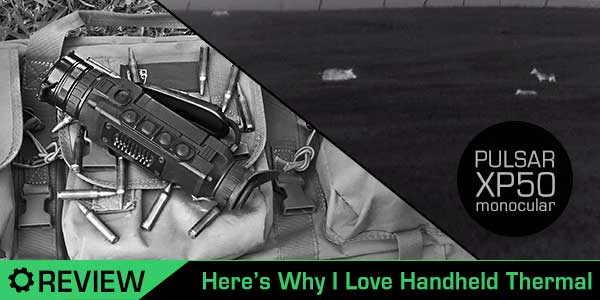 You know the phrase, “You don’t know what you have until it’s gone”? This happened to me in the real world. This all got started because of my superpower. Superpower? Yes, superpower. I have this amazing ability that whenever I go out of town, I always leave something at home. Business conference across the country, left my dress shoes at home. Sister’s high school graduation, left my WHOLE bag at home. Recently, I guided hunts on back to back weekends and on the first weekend I left my rifle bag on my bed and the second weekend left the Pulsar Helion XP50 thermal monocular in my closet, which actually gave me some perspective and helped me with this story. After this last incident, my wife suggested/demanded that I make a physical checklist for anytime I go out of town for any occasion, which is something I will be implementing.
You know the phrase, “You don’t know what you have until it’s gone”? This happened to me in the real world. This all got started because of my superpower. Superpower? Yes, superpower. I have this amazing ability that whenever I go out of town, I always leave something at home. Business conference across the country, left my dress shoes at home. Sister’s high school graduation, left my WHOLE bag at home. Recently, I guided hunts on back to back weekends and on the first weekend I left my rifle bag on my bed and the second weekend left the Pulsar Helion XP50 thermal monocular in my closet, which actually gave me some perspective and helped me with this story. After this last incident, my wife suggested/demanded that I make a physical checklist for anytime I go out of town for any occasion, which is something I will be implementing.
On the guided hunt, fortunately one of the other guides had brought his handheld thermal which we used for the weekend. While any handheld thermal is better than no handheld thermal, it’s also like saying you want to take a cross country trip and you have the option of driving a scooter or a Bentley. Yes, they will both get you to your destination, but you will have two drastically different experiences. Don’t get me wrong, this other thermal got the job done but I didn’t realize how significantly better the Helion XP50 was in comparison until I went back the next weekend to hunt with SHWAT™ Publisher Jonathan.
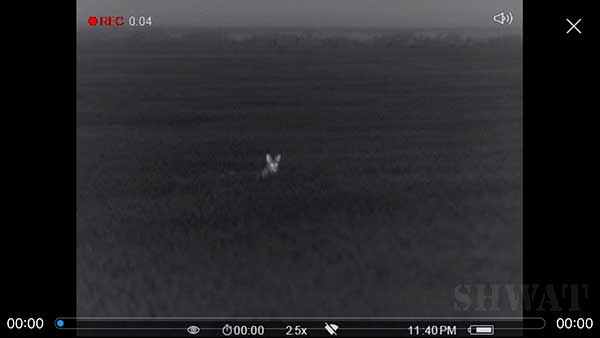
This coyote also blew our cover and was about 50 yards away.
The other thermal has great brand name recognition but the picture was not anywhere in the same ball park as the Pulsar. The images from the Helion XP50 were much more crisp and detailed. Also, there was a HUGE difference in detection range (more on that later).
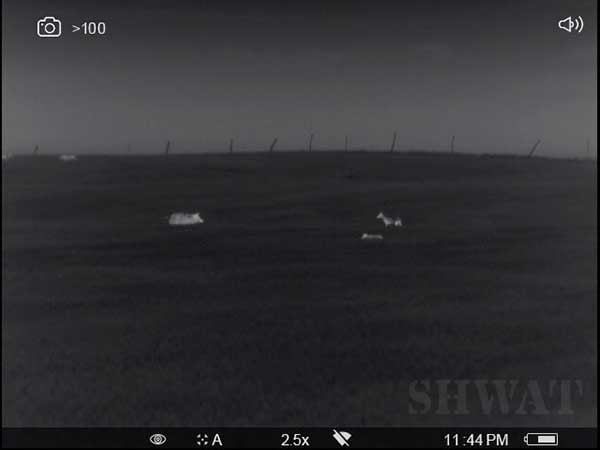
Hog vs. Coyote, the West Texas Standoff! For the record, we won the next round.
The Pulsar Helion XP50 has all the bells and whistles of the Pulsar Trail XP50 (you can read about it here). The onboard recording, Wi-Fi, rechargeable battery, variable magnification, stadiametric rangefinder and Picture in Picture are all included. The first thing I noticed is that the Helion was shorter than the Trail. Pulsar was able to reduce the length from 11.5 inches to 9.2 inches. They were also able to reduce the weight by 4 ounces. Bigger isn’t always better, especially in this environment and I was happy that this was shorter and lighter, especially as much as I carried it.
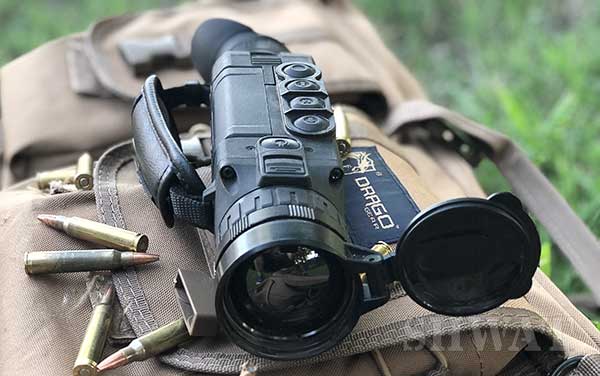
Helion XP50 comes with a flip out lens cap. Manual focus ring behind the lens allow for critical focus, something I occasionally forget to adjust.
Another difference between the Helion and the Trail was that the power button on the Helion was moved from the right side of the unit to the top of the unit. Personally, I liked having all of the buttons in one place and the power button is placed the furthest away from the eyepiece. Instead of 4 buttons on top, there were now 5. All of the buttons function the same as the Trail so it was nice to have that continuity and not have to learn a new system.
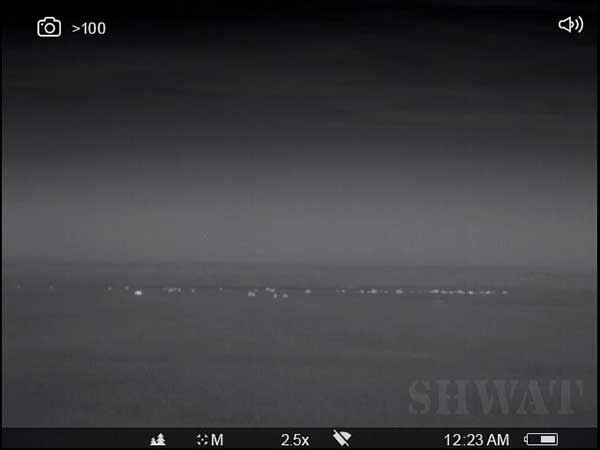
The 160 acre field west of town was filled with these pigs all weekend There were fewer when we got done.
The base magnification on the Helion is 2.5x and digitally zooms to 5x, 10x and 20x (though I didn’t find 20x particularly helpful). This allowed us to really zoom in and get a good look into the fields, but most of the time I stayed with the 2.5x magnification. Like I mentioned before, the images on the Helion are outstanding. Before I left for the hunt, my parents were over and I decided to pull out the thermal and have them look through it in the backyard. When you are around this equipment a bunch, sometimes you take for granted how awesome it really is and it was cool to get someone’s perspective and reaction of something they’ve never seen before. When we went into the backyard, my oldest daughter was still up so she got to be the guinea pig and go into the middle of the backyard. My mom went first and her first words were, “Wow! I didn’t realize you’d be able to see so much detail. I thought it was just going to be a white blob on the screen.” My dad took his turn and had a similar reaction. It’s pretty incredible that with this technology you really could conduct a police lineup through it because you can see that much detail when you are even 15 or more feet away.
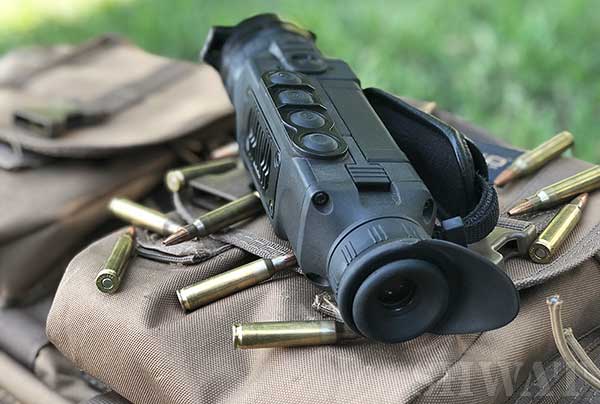
Buttons in a row, pretty intuitive.
The sensor, frame rate and pixel size are exactly the same as the Trail XP50 (640×480, 50 HZ and 17 µm) which is what allows such great imagery. One of the features on the Helion that wasn’t on the trail is that you have 8 different color palettes to choose from. While I did peruse through the different color options, I kept it on the traditional white hot.
One of the things I really wanted to do was test the “detection range” and get a real world number. In one of the sections of land (a section is 640 acres or 1 square mile) there were a group of cattle in the southeast corner and we drove a mile north to the next county road where I turned west and scanned the corner with the cattle. At this point we were around 1760 yards or a mile away and I could distinctly see each cow that was in that corner. It wasn’t a white apparition in the far off distance, but instead I could see each individual bovine. We probably could have kept driving north to really test it but I was satisfied in being able to detect animals a mile away.
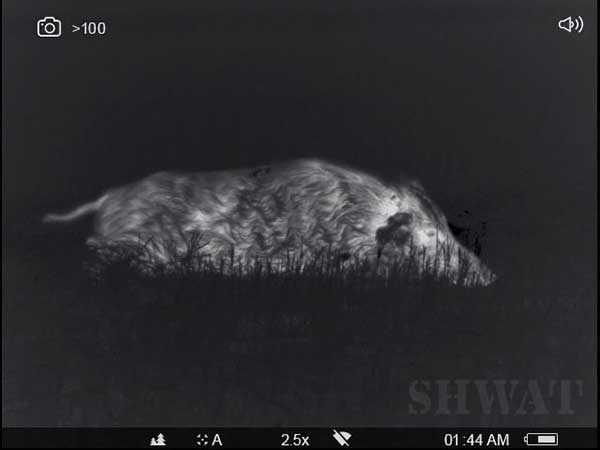
The hunt with Jonathan was one of our best. We ended up killing 24 pigs that we know of and there were a couple of more that we shot but couldn’t locate them in the knee-high, thick wheat. We did find the best way to locate them was to walk perpendicular to the rows of wheat, scanning each row as we passed it and eventually the heat of the deceased animal would show up in our picture. In some places, the wheat wasn’t in a row and we weren’t able to find the pigs in those fields.
I haven’t always been a big believer in the use of a handheld thermal. Part of that is that we just haven’t really ever had one. Previously, we would use whatever thermal scope was attached to our rifle by pulling it off and mounting it back onto the rifle, as long as it had a ZRODELTA mount. Not the most efficient way to do things but we knew by using ZRODELTA mounts there wouldn’t be any issue with accuracy when we returned the scope to the rifle. If the optic didn’t have a ZRODELTA mount, we would scan the fields with the optic on top of the empty, bolt-open rifle. Even though we were very safe in scanning this way, it was troublesome trying to swing an empty rifle around a truck and the Helion has made our experience so much better, safer and more efficient.
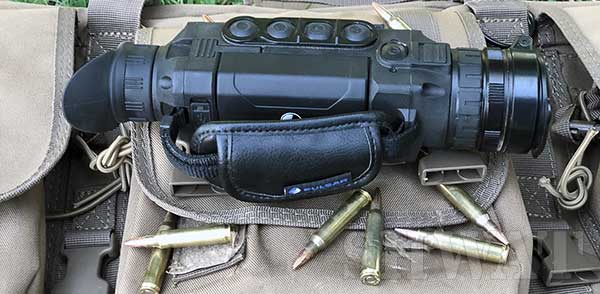 This model of Pulsar’s is right around $4000. Again, this is their top of the line model and they have others that start around $2500. It wasn’t until I started using the handheld Helion that I recognized how beneficial one of these devices are for how we hunt. If you are on the fence and aren’t sure if you want to purchase one, you can always go to Ultimate Night Vision and rent one for the weekend.
This model of Pulsar’s is right around $4000. Again, this is their top of the line model and they have others that start around $2500. It wasn’t until I started using the handheld Helion that I recognized how beneficial one of these devices are for how we hunt. If you are on the fence and aren’t sure if you want to purchase one, you can always go to Ultimate Night Vision and rent one for the weekend.

